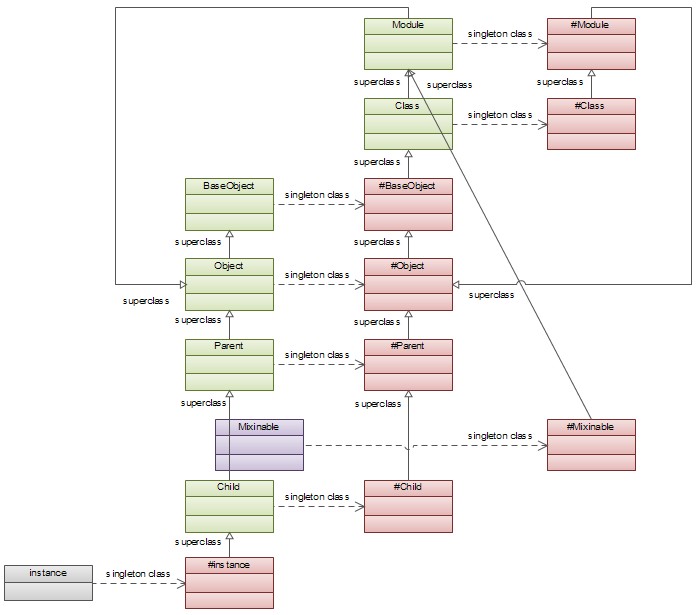备注
如果说哪门语言对我影响最大,那就是Ruby了,在.NET阵营多年,试图去用C#的思维去解释很多东西,当然解释Java是足够了,可惜我也用了好几年去解释Javascript,结果是可想而知的:解释不通。直到我遇到Ruby,这让我了解到一件事:不能用一种语言的思维去解释另外一种语言,当然某些局部特点是有可比性的。
本文重点解释一下Ruby的对象模型(可以理解我Javascript的原型模型),有此可以看出Ruby的完美和统一。
对象模型
无图无真相

基本规则
- 一切皆为对象:instance是一般对象、#instance是临时类型对象、Child是一般类型对象、Class是特殊的元类型对象(其实例是一般类型对象)、Mixinable是一般模块对象、Module是元模块对象(其实例是一般模块对象)。
- 只有实例方法,即方法只能定义在类型上(不像Javascript,可以存储在对象上),即:如果 xxx.class = Class or xxx.class = Module 那么 xxx 可以定义实例方法。
- 所有实例变量只存储在对象自身上(不像Javascript,可以存储在原型链的任何位置)。
- 所有类型都可以在任何时候进行修改(Open Class)。
- instance.method的查找规则:先查看singleton class,然后递归遍历所有super class和Mixed Module,遇到第一个即返回,这个过程也叫:右移一步,然后向上。
代码示例
1 # coding: utf-8 2 3 class Parent 4 def hi() 5 puts "hi" 6 end 7 end 8 9 module Mixinable 10 def hey() 11 puts "hey" 12 end 13 end 14 15 class Child < Parent 16 include Mixinable 17 18 def hello() 19 puts "hello" 20 end 21 end 22 23 instance = Child.new 24 instance.hello 25 instance.hey 26 instance.hi
如何修改Singleton Class?
第一种方式
1 class << instance 2 def instance_singleton_method_one 3 puts "instance_singleton_method_one" 4 end 5 end 6 7 instance.instance_singleton_method_one
第二种形式
1 def instance.instance_singleton_method_two 2 puts "instance_singleton_method_two" 3 end 4 5 instance.instance_singleton_method_two
如何修改类型,如Child?
注意:下面演示的是“Open Class”,不是重新定义一个类型。
1 class Child 2 def child_method_one() 3 puts "child_method_one" 4 end 5 end 6 7 instance.child_method_one
类型方法是特殊的实例方法,这些方法定义在类型的Singleton Class中。
第一种方式
1 class Child 2 def Child.child_class_method_one() 3 puts "child_class_method_one" 4 end 5 end 6 7 Child.child_class_method_one
第二种形式
1 class Child 2 def self.child_class_method_two() 3 puts "child_class_method_two" 4 end 5 end 6 7 Child.child_class_method_two
第三种形式
1 def Child.child_class_method_three 2 puts "child_class_method_three" 3 end 4 5 Child.child_class_method_three
第四种形式
1 class << Child 2 def child_class_method_four() 3 puts "child_class_method_four" 4 end 5 end 6 7 Child.child_class_method_four
备注
图中很多关系有兴趣的朋友可以自己验证,本文没有涉及元编程,元编程不过是按照一定的元数据来修改类型定义或生成类型定义,也就是说元编程的前提是类型可以动态的修改,了解了本文,元编程不在话下。